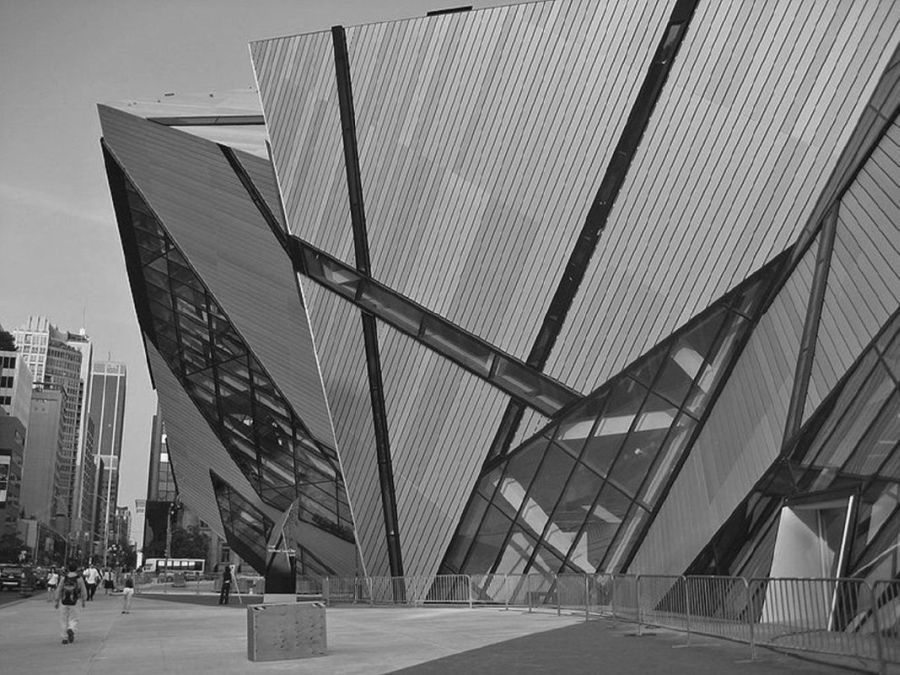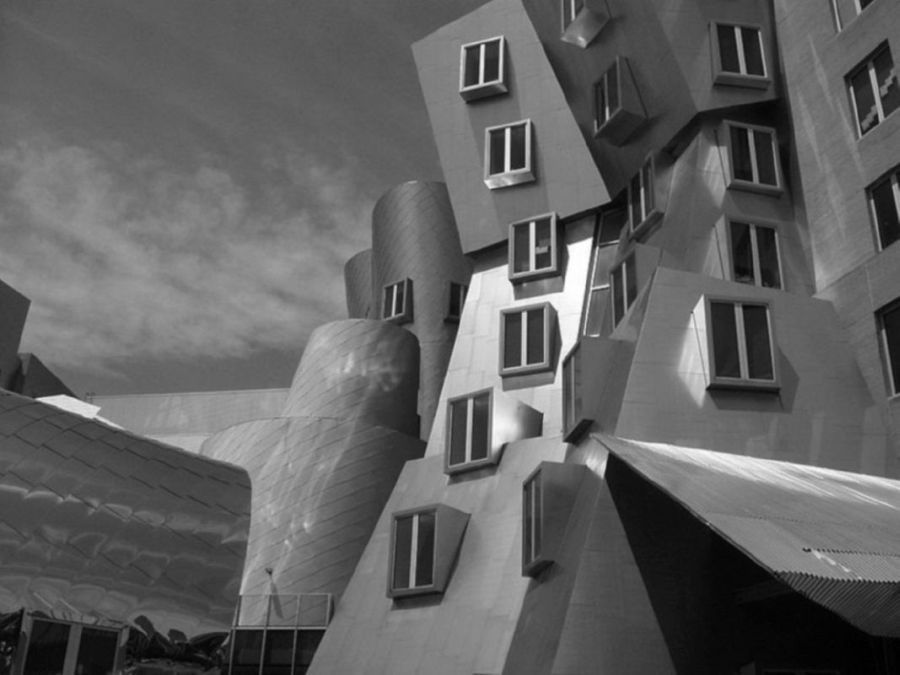About architecture
Away, then, with the structures, mechanical systems, with curtain walls, with emergency staircases, parapets, false ceilings, projectors, pedestals, showcases. If their functions must be retained, they must disappear from our view and our consciousness, vanish before the sacred objects so we may enter into communion with them.
Jean Nouvel describing Musée du quai Branly, Paris, France, 2006
There is an apocryphal story, popular amongst architectural students, that upon leaving a Rem Koolhaas lecture, a bewildered attendee was asked by a colleague what it had been about. ‘I have absolutely no idea,’ the hapless listener replied, ‘either I’m stupid or that guy’s a genius.’ Apocryphal or not, this charming anecdote indicates a prevailing perception amongst many in society, not the least of whom are baffled architecture students, that much of the language adopted by architects is utterly unintelligible. Flowery prose, pretentious musings, convoluted phraseology and intellectual narcissism are just some of the accusations leveled against the type of language adopted by some in the profession.
Even popular culture has taken the bait. Hollywood once portrayed architects as stoic, virtuous, and dependable, essentially idealized heroic versions of the common man. Witness the human Mount Rushmore that is Gary Cooper’s Howard Roark in the 1949 dramatization of Ayn Rand’s novel The Fountainhead. Or even Paul Newman’s solidly tenacious everyman in The Towering Inferno of 1976. Jump forward a few decades and we have the architect in the Matrix trilogy, a grey-suited, mustachioed, imbecilic dandy spouting forth all manner of nonsensical verbiage about cosmic anomalies and prophetic infiltration.
Of course, it is easy to see why these perceptions exist when we look for examples of hubris within architectural discourse. There is a hardcore coterie of celebrated architects who insist on propagating an esoteric style of language that is not only completely incomprehensible to laypeople but to scores within their own profession. As the extract below demonstrates Peter Eisenman is one of the worst offenders. In fact, if Churchill said that the Soviet Union was a ‘riddle wrapped in a mystery inside an enigma’ then Peter Eisenman is the Siberian snowstorm that obscures all three:
Our project represents an attempt to rethink the symbolism of the vertical office building. Traditionally, the vertical building had two metaphoric connotations, one as a metaphor for anthropocentrism (the human vertebrae as upright, symmetrical and skeletal) and the other as a symbol of power and dominance, in particular, phallocentrism. Our building symbolically seeks to undermine these two centrisms, first by producing a building that is not metaphorically skeletal or striated … and second, by producing an image somewhere between an erect and a ‘limp’ condition.
FIGURE 25.1 Example of Eisenman’s use of sloping windows and ground planes at the Greater Columbus Convention Center
Source: Mark Olson.
Here Eisenman is describing his Nunotani Corporation Headquarters, built in Tokyo, Japan, in 1992. The building is painted bright pink and features sloping walls, windows and parapets as if it is virtually disintegrating into the ground, a common deconstructivist ruse. Eisenman’s bombast, however, does no favours for those who wearily contend that modern architectural output has nothing to do with male appendages by reminding everybody, in the most ludicrously cryptic and convoluted way possible, that that’s exactly what his concept involves. Despite his best efforts, the message couldn’t have been clearer had this bizarre building been wrapped in latex and given zips for windows.
And yet, despite this patent failure to grasp the core essentials of communication, Eisenman has been deified by the global architectural academic establishment and force-fed to thousands of architectural students across the world, inevitably reducing most of them to various stages of bafflement and distress (see Figure 25.1 for an example of his work). Why? Is this the way the architectural profession wishes to be perceived by the outside world? Are pomposity and obfuscation really the skills that it wishes to bequeath to the next generation of architects?
Sadly Eisenman is not alone but it is not necessarily to his countrymen in the United States that we must turn for further evidence of this disturbing trend but Europe. Europe has produced scores of architects who happily revel in the egregious excesses of architectural hubris. France is perhaps the key culprit. Unlike England which has for centuries taken great pains to fastidiously foster a robust suspicion of overt intellectualism, in France philosophical proselytizing of the kind so adored by Eisenman and his ilk has been elevated to a religion. Jean Nouvel, as his description of his 2006 Musée du quai Branly in Paris shows, is a habitual and unrepentant offender:
everything is designed to evoke an emotional response to the primary object, to protect it from light, but also to capture that rare ray of light indispensable to make it vibrate and awaken its spirituality.
However, Nouvel’s evidently slender grip on reality is insufficient to usurp the throne occupied by that Grand Wizard of Obfuscation, the undisputed Master of Miasma, fellow Frenchman Bernard Tschumi. Attempt to decipher his description of Paris’s baffling Parc de la Villette (1988) at your peril:
The park’s architecture refuses to operate as the expression of a preexisting content, whether subjective, formal or functional. Just as it does not answer to the demands of the self (the sovereign or ‘creative’ architect), so it negates the imminent dialectic of the form, since the latter is displaced by superimpositions and transformations of elements that always exceed any given formal configuration. In a Nietzschean manner, La Vilette moves towards interpretative infinity, for the effect of refusing fixity is not insignificance but semantic plurality.
Tschumi represents everything that is alarming about contemporary architectural discourse. Unintelligible and impenetrable in equal measure, vacillating remorselessly from one indecipherable theory to another, this is a gross and corpulent corruption of language that succeeds in illuminating nothing other than the author’s own narcissism and vanity. So much so that one imagines that Tschumi would answer even simple requests for directions or the time with sonnets and soliloquies charged with such withering uber-intellectual ferocity as to transform even the most ardent linguist into a supplicating pile of smouldering ash by the time he had finished. Like Eisenman he has spent much of his career tormenting architectural students, but at least Eisenman’s tirades provide unintentional humour; Tschumi is just blow after blow of unsaturated cerebral haemorrhaging. It is a matter of extreme injustice that while one imagines that his buildings are subject to all manner of health and safety scrutiny, his pen is allowed to proceed unimpeded.
Alas, Tschumi, Nouvel and Eisenman do not operate in isolation. Behind every one of them there is a Koolhaas, Hadid, Herzog, Libeskind or Ando patiently waiting in the wings equally willing to shatter linguistic clarity to pieces. Why? Why do some architects feel the urge to embalm their message beneath layers of cryptically choreographed conceit of this kind? Is deconstructivist architecture the answer? The term could readily be applied to the work of at least Eisenman and Libeskind (Figure 25.2) and deconstructivism’s theoretical emphasis on semiotic distortion and structural dislocation would appear to make it a natural bedfellow of linguistic dissembling. However, while a seductive theory it is ultimately a hollow one. Sadly architectural hubristic affinity extends far beyond the proponents of deconstructivsm and there are even those who practise the style who have been known to occasionally make sense. Gehry’s buildings may look like the frenzied work of a deranged sculptor (Figure 25.3) but Gehry himself tends to communicate with relative clarity and simplicity.
FIGURES 25.2 The shattered building style of Libeskind’s addition at the Royal Ontario Museum compared to the frenzied work of Gehry at MIT’s Stata Center in FIGURE 25.3 Source: Wikipedia, May 19, 2014.
Could the reason be centred on the collapse of Modernism in the 1970s? For all their architectural radicalism, the likes of Frank Lloyd Wright, Louis Kahn or even Le Corbusier made far more sense than many of their successors today. Le Corbusier’s ‘machine for living’ may have been a controversial idea, but it is easy to grasp what he meant. Equally, Mies van der Rohe could hardly have been plainer when he penned the now timeless maxim ‘less is more’. But with the fall of Modernism many of its exponents took refuge in the less contentious world of academia and pseudo-intellectualism. Banished from building tower blocks and flyovers they resorted instead to proselytizing about philosophical theory, dressing their prose in the kind of indecipherable garb that they presumed lent integrity to the ideas that had been discredited in the real world. Might it not even be the case that rather like the bully who shields his cowardice with aggression, some architects adopt the linguistic modes and conventions of academic intellectualism to conceal the very poverty of intellect that lies behind their own work and ideas? Essentially, despite the fact that pretentious prose is clearly harnessed to subconsciously imply architectural quality by association, might it actually be being deployed to conceal dross, insecurity and ineptitude?
FIGURES 25.3 The shattered building style of Libeskind’s addition at the Royal Ontario Museum in Figure 25.2 compared to the frenzied work of Gehry at MIT’s Stata Center
Source: Wikipedia, May 19, 2014.
These academic or even philosophical pretensions, however, are yet another extension of the core question that has dogged architecture since the Enlightenment and which could well offer yet another possible explanation for architectural hubris: is architecture an art or a profession? So much of the everyday practice of modern architecture is concerned with the prosaic execution of the latter (contracts, legislation, management, coordination, etc.) that perhaps language is employed as a device to reassure some within the profession that their labours are ultimately connected with the core, civilizing human condition of creativity and therefore separated from other (baser) vocational occupations such as law and medicine. These are not problems encountered by the musician or the painter. They are clearly producing a form of art and need no further didactic recourse to validate their efforts as such. But with architecture, particularly in an increasingly codified and regulated world, there is perhaps the compulsion to intensify, however disingenuously, its artistic credentials.
And what of the role of the architect within this increasingly codified and regulated world? It is perhaps no coincidence that the rise of architectural hubris from the 1970s directly corresponds with the erosion in the power and influence of the architect. In 1963 when prolific English architect Richard Seifert was progressing plans for a controversial 34-storey tower block in the heart of historic central London, he bluntly informed the local planning authority that ‘we shall be glad to discuss any amendments but it is important that the bulk of the building should not be reduced’. Such hectoring authoritarianism from any architect today, not to talk of one as shamelessly commercialized as Seifert, would be unthinkable.
The architect was once the undisputed master craftsman, the all-powerful chief consultant whose influence was as keenly felt on the construction site as in the draughtsman’s office. But now a whole raft of contractual, technological, and professional changes has undermined this position almost beyond recognition with innovations such as design and build contracts, project managers and even the democratizing influence of BIM technology gradually eating away at the roles and responsibilities that were once the cherished and exclusive domain of the architect. As the world emerges from recession and clients and contractors wish to extract ever more value from the construction process, this trend is likely to accelerate. Might it not be the case that when faced with these humiliating incursions some architects, driven by professional paranoia and a defiant, defensive compulsion to protect what is left of architectural identity, have subconsciously retreated into a safe harbour which no other new consultant or process can invade – language?
So, it would seem that the reasons why some architects employ hubristic language are far from clear. What is perfectly clear, and gravely so, are the consequences. If we accept that architecture is an art form then we must surely acknowledge that it is a unique one. It is the only art form that affects all the senses; even the blind man must still feel his way up the stairs and have a room in which to lie in bed at night. Architecture is the universal tool that shapes our built environment which is why the language architects use is so important. Of course we are all familiar with the terms medical or legal jargon but it is only architectural jargon that has the potential to impoverish and confuse an individual’s relationship with their surrounding context.
There can be only two inevitable consequences of architects continuing to use language in this way. First, the exacerbation of the perception that architects are arrogant and elitist and second, and even more worryingly, the increasing severance of the relationship between the architectural profession and the public. Already, in the eyes of many, architects have an image problem. They are frequently seen as overly proud and hopelessly egotistical, more concerned with impressing their peers and imposing their superiority than with serving the public. All of which are shortcomings that a committed propensity for infantile linguistic contortionism will only serve to worsen.
But even more serious is the potential detachment from the public that hubristic language threatens to exact. The relationship between architects and the public is critical to the success of any civilized society. Of course architecture is a career and a vocation; some architects have even been known to make money. But with the privilege of being able to the shape the built environment comes the unique covenant of responsibility with the general public that dictates that the social consequences of architectural intervention must be benign. Therefore it is absolutely crucial that the relationship between the architect and the public is based on mutual trust and understanding. But how can there be any understanding when one half of this relationship speaks, quite literally, in a different language?
Few of us enjoy being made to feel stupid, but this is the inevitable consequence of language specifically constructed to divide rather than divulge. Those not interested in intellectual masochism will eventually end the conversation and simply walk away. This is the danger of a public who cannot engage with its architects; the conversation becomes one-sided which ultimately renders it futile. Frustration, spite and resentment will eventually ensue from both sides; change takes place as it inevitably always does but without intellectual investment from one side and overburdened by intellectual prerogative on the other, as history has consistently shown us, it is ultimately doomed to failure.
Things need not be thus. Language is one of humankind’s greatest gifts; it is one of the few precious physiological capabilities that separate us from the animal kingdom. Language should liberate not constrain, reveal and not restrict. Language has an innately liberalizing, democratic and empowering influence; turning it into a grubby semiotic code enjoyed by a chosen few keen to suppress their insecurities about their perceived skill, role or identity by loudly proclaiming their membership of an exclusive cerebral club is a pernicious corruption of the social and cultural benevolence that language has the potential to bestow.
If architects were to learn that language is the tool and not the product, then its power to strengthen and clarify our relationship with both architects and our surroundings would be infinite. Is it not ironic that one of the earliest architectural structures attributed to Christian civilization is the Tower of Babel, a monstrous citadel to avarice and arrogance whose eventual impact was to segregate and confuse? Cynics may interpret this biblical echo as allegorical proof that some things never really change; for the future of architectural discourse and society as a whole, let us hope that they eventually do.
Note
A shorter version of this piece appeared in the 18 December 2013 issue of Building magazine (London), titled ‘How to Speak Architect’.


